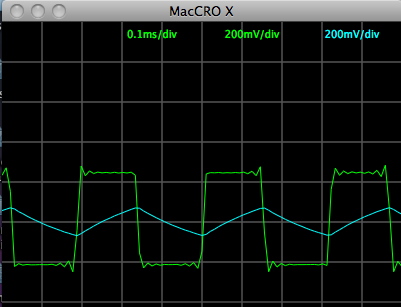
LapTop BreadBoarding
Analog Breadboarding on a laptop costs almost nothing,
at least on a MacBook Pro. (Should be better for PCs)

Three things make laptop breadboarding convenient.
1)A USB port is designed to provide 5volts at up to 500mA.
2)Sound recording inside PCs is becoming commonplace.
3)A lot of free software is available online.
These three items together with a little interface development
can turn a laptop into a full audio bread-board lab environment.
Outside of the breadboard, the full interface needed is shown below.
<< THIS IS NOT A NOVICE PROJECT >>
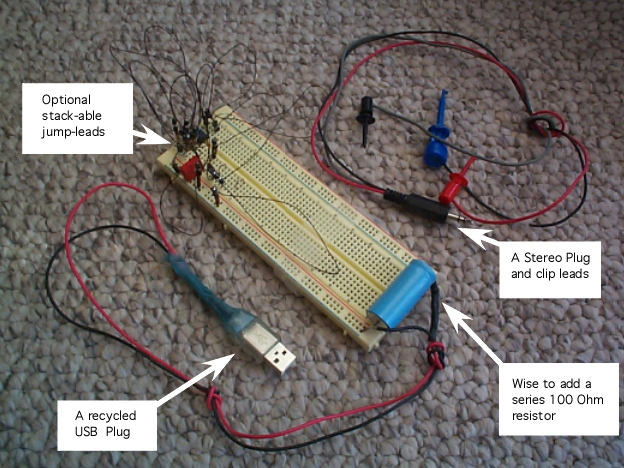
The MacBook provides a line-input stereo audio port
in addition to its internal microphones.
It looks like this port can only handle signals
at the standard audio levels.
USB devices tend to become an open circuit right at the plug interface.
The wires in this USB plug were wired to the correct color code.
The 5V wire was red and the ground as black.
Apparently a 100mA load is a unit load for USB.
A 100 Ohm series resistor was added to the 5V line for safety reasons.
<< THIS IS NOT A NOVICE PROJECT >>

If the breadboard looks a little strange,
it is because some stack-able jumper-leads were made up
to make hooking up everything much easier. (Optional)
Outside of the interface, everything else that is needed
is either already inside a MacBook Pro
or can be downloaded off the web for free.
One excellent program for a Mac is Macspice.
This program is completely free and seems to be continually supported.
A simple simulation of the breadboard will show what should be expected.
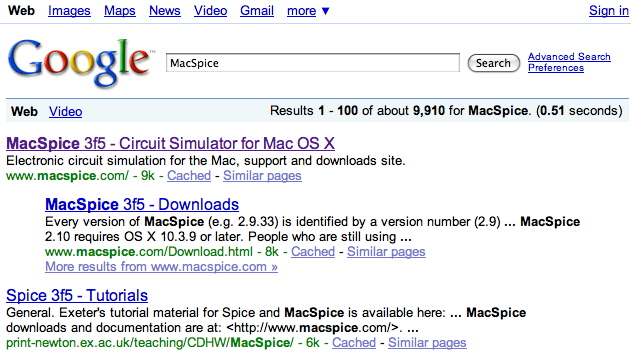
A simple triangle/square wave oscillator shown below
will be the laptop's first circuit.
A low supply current RRIO OpAmp was used in the breadboard.
(In this case a LM6132).
The output at node "OUT1" will go very close from zero to 5V.
But since the audio input port for a MacBook
only accepts audio level inputs,
R5 and R6 are needed to reduce the signal level.
Op Amp OPA2 buffers the triangle wave and it needs to be attenuated too.
FIRST_LAP_TOP_0
*
* ^ 5V
* /_\ R3
* | 10k 10k
* |_/\ /\ /\_____/\ /\ /\_
* R1 \/ \/ | \/ \/ |
* | |
* R2 | |
* _/\ /\ /\_|INP1 |\ | 100k R5
* | \/ \/ |_____|+\ OUT1 | ___
* _|_ 10k | \_____|___/\ /\ /\___|CH1|
* /// INN1 | / | \/ \/ | |___|
* C1 __________|-/ | |
* _|_ | |/ OPA1| R6 |
* ___ | | _/\ /\ /\_|
* | | R4 10k | | \/ \/
* _|_ |_/\ /\ /\_| | 1k
* /// | \/ \/ _|_
* | ///
* |INP2|\
* |____|+\ OUT2 100k R7 ___
* | \__________/\ /\ /\___|CH2|
* INN2 | / | \/ \/ | |___|
* ____|-/ | |
* | |/ OPA2 | R8 |
* | | _/\ /\ /\_|
* |_____________| | \/ \/
* | 1k
* _|_
* ///
*
The full simulation code is shown below and yields the following graphs.
VCC VCC 0 DC 5
R1 VCC INP1 10K
R2 INP1 0 10K
BOPA1 OUT1 0 v = 2.5*tanh((v(INP1)-v(INN1))*1000) +2.5
R3 INP1 OUT1 10K
R4 INN1 OUT1 10K
R5 OUT1 CH1 100K
R6 CH1 0 1K
C1 INN1 0 .022u IC=1
BOPA2 OUT2 0 v =v(INN1)
R7 OUT2 CH2 100K
R8 CH2 0 1K
.tran 3u 5m 3u UIC
.control
set pensize = 2
run
plot v(ch1) v(ch2)
plot v(ch1) v(ch2) xlimit 2m 2.5m ylimit -50m 50m
.endc
.end
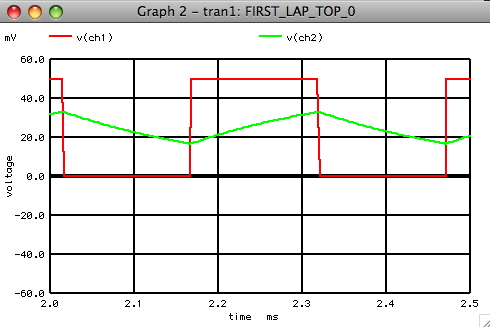
The next great free program is called MacCRO X.
This is alpha version of a simulated oscilloscope,
so everything is not perfect.
But when the breadboard is powered up from the USB port
and clip leads connect analog signal to the audio input port,
the behavior of the breadboard can be viewed real time.
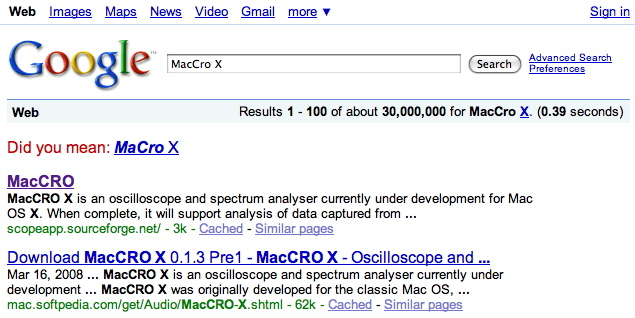
The present version of MacCRO X allows some adjustments
in both time and voltage magnitude.
The trigger feature does not appear to be working well.
But there is a button to freeze the scope trace.
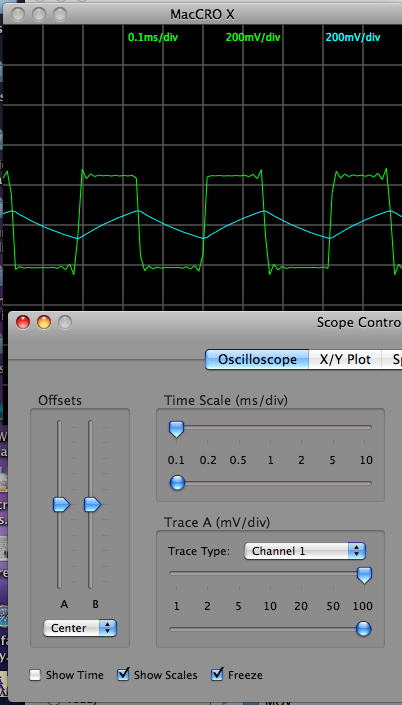
This is a dual trace oscilloscope which is powerful.
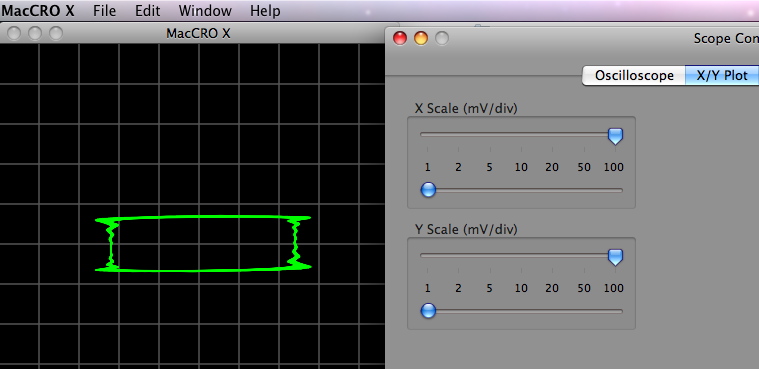
For those of us who believe in trusting nothing,
now its possible to sanity check real time analog waveforms
with simulations on the same laptop, all at the same time.
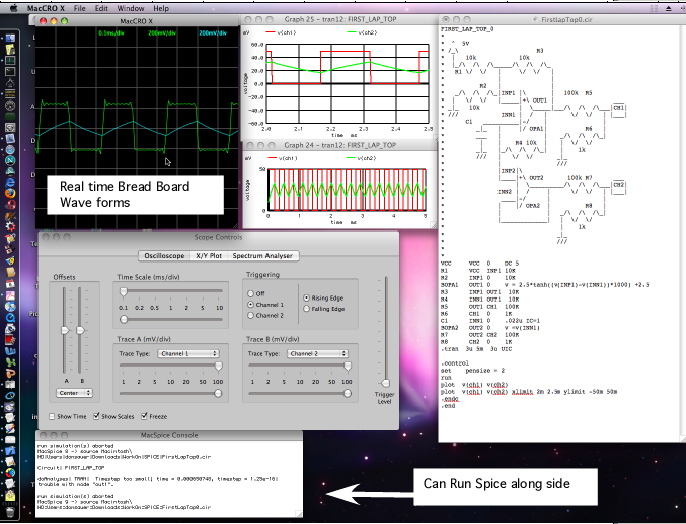
The present version of MacCRO X appears to neither trigger well
nor store waveforms in a convenient manner.
That is where another great free program comes in.
While there are many programs that can record audio signals,
Audacity appears to be the best.

Having the ability to capture a large amount of dual trace data
is very powerful when it come to debugging any hardware.
The dual trace feature makes it much easier
to hunt down cause and effect relationships.
While MacCRO X lacks
the triggering power of a oscilloscope,
Audacity can capture and display a large amount of data
which can then be looked over to find a particular event.
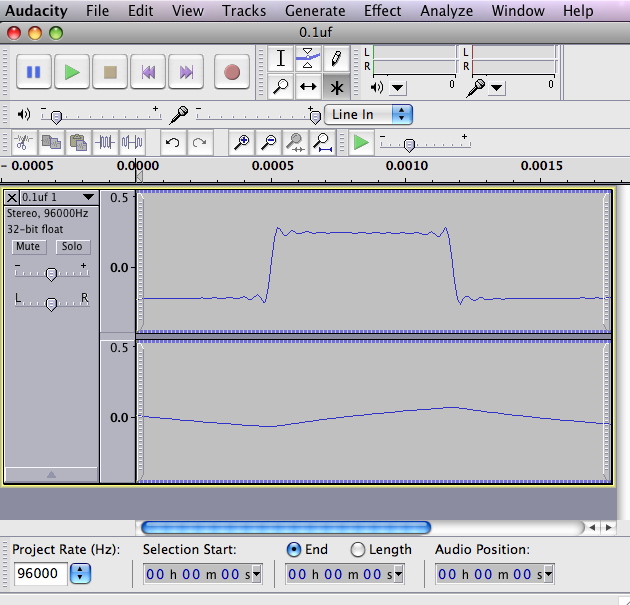
If one wants to get into things a little deeper,
Audacity allows trimming of captured signal
which can be exported to aiff format.
It appears that the following is the default export setting.
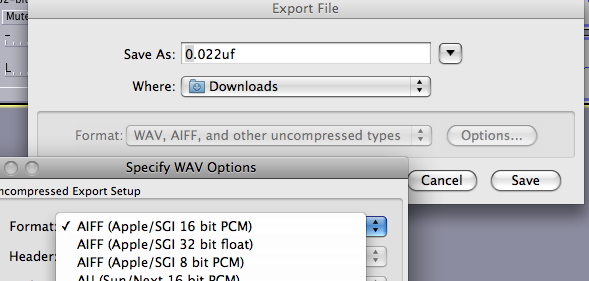
While the aiff format is binary,
it is not too hard to write a little C++ program on the Mac
to translate the binary format into text format.
The compiled Mac translation program is called aiff2txt.
The source is included here.
After exporting a wave shape to .aiff format,
this file needs to be in the same directory as the
aiff2txt program.
Open up a terminal.
Cd to the directory containing both files
and type in the program name and audio file name as follows...
don-sauers-macbook-pro:Oscilloscope donsauer$ ./aiff2txt fileName.aiff
fileName.aiff file size is 910
ADDR TYPE VALUE
0 IFF_HEADER FORM
4 FILE_SIZE 902
8 TYPE_AIFF AIFF
12 COMMON_CHUNK COMM
16 CHUNK_SIZE 18
20 NUMB_CHAN 2
22 NUMB_FRAM 214
26 SAMP_SIZE 16
28 SAMP_RATE 96000
38 SSND_CHUNK SSND
42 CHUNK_SIZE 864
46 OFFSET 0
50 BLOCK_SIZE 0
Output is stored in <converted_aiff.txt>
The text output is called converted_aiff.txt
and will contain the following data.
filename = fileName.aiff
file size = 910
ADDR TYPE VALUE
0 IFF_HEADER FORM
4 FILE_SIZE 902
8 TYPE_AIFF AIFF
12 COMMON_CHUNK COMM
16 CHUNK_SIZE 18
20 NUMB_CHAN 2
22 NUMB_FRAM 214
26 SAMP_SIZE 16
28 SAMP_RATE 96000
38 SSND_CHUNK SSND
42 CHUNK_SIZE 864
46 OFFSET 0
50 BLOCK_SIZE 0
0 -7348 372
1.04167e-05 -7263 303
2.08333e-05 -7196 247
3.125e-05 -7218 187
4.16667e-05 -7271 117
5.20833e-05 -7274 41
6.25e-05 -7230 -32
7.29167e-05 -7189 -98
8.33333e-05 -7194 -163
9.375e-05 -7215 -229
0.000104167 -7224 -296
0.000114583 -7201 -357
0.000125 -7174 -415
0.000135417 -7169 -475
0.000145833 -7187 -544
0.00015625 -7205 -616
0.000166667 -7193 -683
0.000177083 -7160 -736
0.0001875 -7149 -777
0.000197917 -7171 -819
0.000208333 -7206 -868
0.00021875 -7191 -931
0.000229167 -7134 -1002
0.000239583 -7095 -1075
0.00025 -7140 -1140
...
The Stereo audio output lists time, then channel one, then channel two.
This format can be copied into a spreadsheet and displayed as so.
And it could also be translated into a format that can run on spice.

Given the present state of both the hardware and software
available on a MacBook Pro,
it looks like getting some hands-on analog experience
might be getting much easier in the future.
On a 17 inch MacBook,
there is a convenient place to scotch tape the breadboard to the laptop
where it is stable and out of the way.
The use of stack-able jumpers
make hook up far faster and easier compared to a soldering iron.
It is not obvious things could not get even easier.
4/8/9
dsauersanjose@aol.com